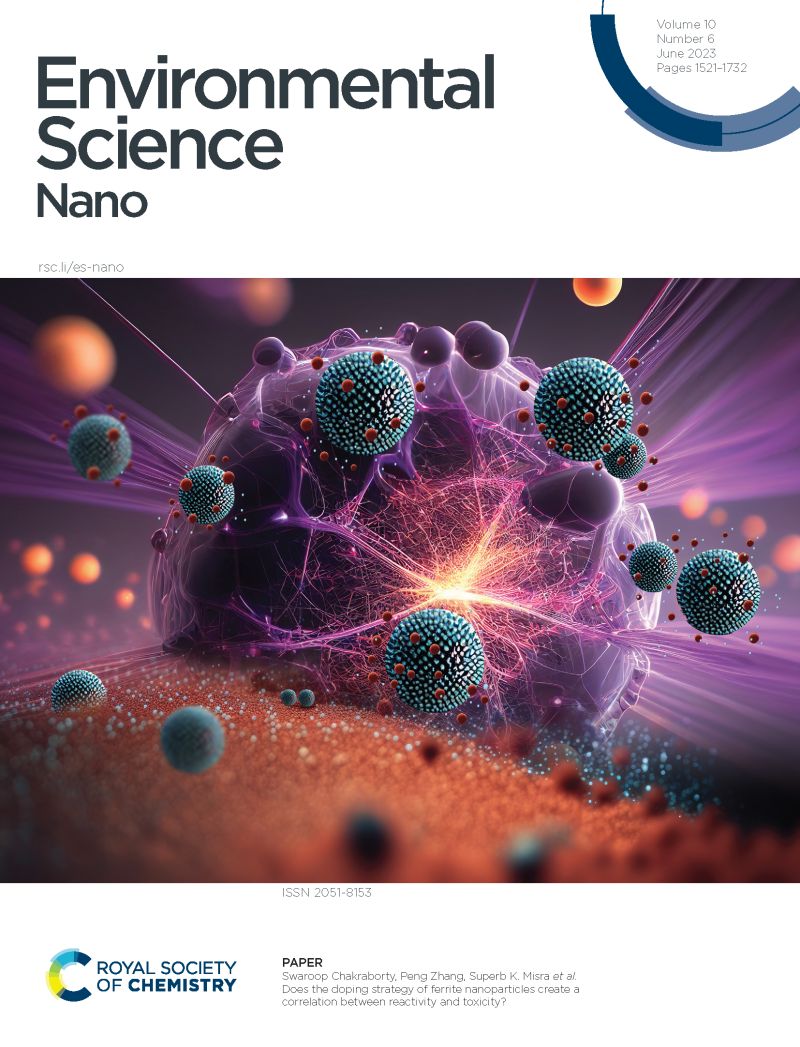Nanoparticle-mediated mitigation of salt stress-induced oxidative damage in plants: insights into signaling, gene expression, and antioxidant mechanisms
IF 5.8
2区 环境科学与生态学
Q1 CHEMISTRY, MULTIDISCIPLINARY
引用次数: 0
Abstract
Salt stress presents a major challenge to global agriculture, leading to decreased crop yields, diminished food quality, economic losses, and threats to food security. Elevated salinity levels enhance the production of reactive oxygen species (ROS), such as superoxide anions (O₂•−), hydrogen peroxide (H₂O₂), hydroxyl radicals (•OH), and singlet oxygen (¹O₂). These ROS can inflict severe damage on cellular components, including proteins, lipids, carbohydrates, and DNA. Although plants have innate antioxidant defenses to mitigate ROS effects, these defenses often fall short under salinity stress, leading to oxidative damage, stunted growth, and diminished productivity. Recent research highlights the potential of nanoparticles (NPs) to enhance plant resilience against salinity-induced oxidative stress. Various types of NPs, metal oxide nanoparticles (e.g., Fe₂O₃, TiO₂, ZnO, CeO₂, Se NPs), silicon-based nanoparticles (e.g., Si NPs, SiO₂ NPs), noble metal nanoparticles (e.g., Ag, Au-Ag alloy NPs), carbon-based nanoparticles (e.g., graphene oxide, carbon NPs), chitosan NPs, and composite/functionalized NPs (e.g., polyacrylic acid coated nanoceria, calcium-silicon NPs, selenium-chitosan NPs) can enhance plant resilience to salinity-induced oxidative stress. They enter plants through leaves, roots, or seeds. Once within plant cells, these NPs can act as direct scavengers of ROS or modulate antioxidant defense system. They affect signaling ions such as calcium, signaling molecules like nitric oxide (NO) and phytohormones, and regulatory factors like transcription factors (TFs), thereby regulating gene expression and production of antioxidant enzymes. Moreover, NPs can enhance the accumulation of non-enzymatic antioxidant compounds, such as ascorbate (AsA) and glutathione (GSH), further strengthening a plant’s ability to withstand oxidative stress. As research advances, understanding the full potential of NPs to mitigate salt stress and enhance agricultural sustainability is crucial. However, the long-term environmental impacts of NPs must also be carefully evaluated to ensure their safe and sustainable use.纳米颗粒介导的盐胁迫诱导的植物氧化损伤的缓解:对信号,基因表达和抗氧化机制的见解
盐胁迫是全球农业面临的一项重大挑战,会导致作物减产、食品质量下降、经济损失并威胁粮食安全。盐度升高会促进活性氧(ROS)的产生,如超氧化物阴离子(O₂--)、过氧化氢(H₂O₂)、羟自由基(-OH)和单线态氧(¹O₂)。这些 ROS 可对蛋白质、脂类、碳水化合物和 DNA 等细胞成分造成严重破坏。虽然植物具有先天的抗氧化防御能力来减轻 ROS 的影响,但在盐度胁迫下这些防御能力往往会失效,从而导致氧化损伤、生长受阻和生产力下降。最近的研究突显了纳米粒子(NPs)在增强植物抵御盐度引起的氧化应激方面的潜力。各种类型的纳米粒子、金属氧化物纳米粒子(如 Fe₂O₃、TiO₂、ZnO、CeO₂、Se NPs)、硅基纳米粒子(如 Si NPs、SiO₂ NPs)、贵金属纳米粒子(如 Ag、Au-Ag 合金 NPs)、碳基纳米粒子(如氧化石墨烯、碳 NPs)等都能增强植物对盐分诱导的氧化胁迫的抵抗力、氧化石墨烯、碳 NPs)、壳聚糖 NPs 和复合/功能化 NPs(如聚丙烯酸包覆纳米铈、钙硅 NPs、硒壳聚糖 NPs)可增强植物对盐分引起的氧化应激的抵抗力。它们通过叶片、根或种子进入植物体内。一旦进入植物细胞,这些 NPs 可直接清除 ROS 或调节抗氧化防御系统。它们会影响钙离子等信号离子、一氧化氮(NO)和植物激素等信号分子以及转录因子(TFs)等调节因子,从而调节基因表达和抗氧化酶的产生。此外,氮磷还能促进抗坏血酸(AsA)和谷胱甘肽(GSH)等非酶抗氧化化合物的积累,进一步增强植物抵御氧化压力的能力。随着研究的深入,了解氮磷化合物在缓解盐胁迫和提高农业可持续性方面的全部潜力至关重要。然而,还必须仔细评估氮磷钾对环境的长期影响,以确保安全和可持续地使用氮磷钾。
本文章由计算机程序翻译,如有差异,请以英文原文为准。
求助全文
约1分钟内获得全文
求助全文
来源期刊

Environmental Science: Nano
CHEMISTRY, MULTIDISCIPLINARY-ENVIRONMENTAL SCIENCES
CiteScore
12.20
自引率
5.50%
发文量
290
审稿时长
2.1 months
期刊介绍:
Environmental Science: Nano serves as a comprehensive and high-impact peer-reviewed source of information on the design and demonstration of engineered nanomaterials for environment-based applications. It also covers the interactions between engineered, natural, and incidental nanomaterials with biological and environmental systems. This scope includes, but is not limited to, the following topic areas:
Novel nanomaterial-based applications for water, air, soil, food, and energy sustainability
Nanomaterial interactions with biological systems and nanotoxicology
Environmental fate, reactivity, and transformations of nanoscale materials
Nanoscale processes in the environment
Sustainable nanotechnology including rational nanomaterial design, life cycle assessment, risk/benefit analysis
 求助内容:
求助内容: 应助结果提醒方式:
应助结果提醒方式:


